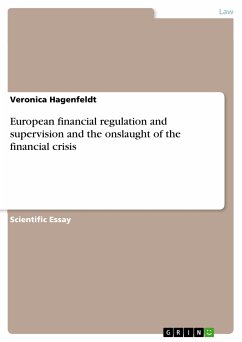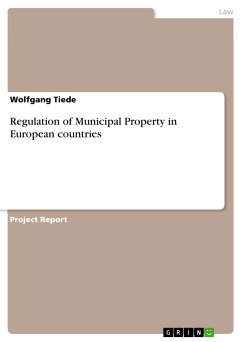Scientific Essay from the year 2009 in the subject Law - European and International Law, Intellectual Properties, grade: Distinction, University of Edinburgh (School of Law), course: Regulatory governance in the European Union, language: English, abstract: The aim of this paper is threefold: first to establish how the regulatory and supervisory architecture has evolved in Europe over the last decade; second to determine how the shortcomings of the present system affected the onslaught of the financial crisis in Europe; and lastly to evaluate whether the proposed regulatory and supervisory reforms are likely to successfully repair these weaknesses. Part I identifies that the single market objective, combined with the significant integration of European financial services, provided the major impetus for bringing about reform to the regulatory and supervisory architecture of Europe. By investigating the Financial Services Action Plan (FSAP) and the implementation of the Lamfalussy Process, this paper illustrates that the member states and the EU institutions sought to achieve a flexible regulatory and supervisory structure marked by cooperation and conversion towards common standards. However, despite the commendable progress made, Part II shows that the regulatory and supervisory system has not kept pace with the financial integration, and that the current crisis revealed substantial inadequacies of the present system. This paper will demonstrate that the weaknesses in the European financial regulatory and supervisory architecture acted both as contributing causes of the crisis, and as exacerbating factors. In particular the essay identifies three such shortcomings that aggravated the crisis, namely that the current system caused a breakdown in member state cooperation and coordination, that it is marked by inconsistency, and that it lacks a sufficiently developed EU-dimension. Lastly, Part III investigates the proposed regulatory and supervisory reforms that the de Larosière Report brought forth. The Report makes recommendations for extensive reform and it is submitted that not only are these reforms likely to cure many of the current cooperation and convergence problems, but they would also equip Europe with a partially centralised supervisory structure that would help prevent future crises of similar cataclysmic proportions.
Dieser Download kann aus rechtlichen Gründen nur mit Rechnungsadresse in A, B, BG, CY, CZ, D, DK, EW, E, FIN, F, GR, HR, H, IRL, I, LT, L, LR, M, NL, PL, P, R, S, SLO, SK ausgeliefert werden.









